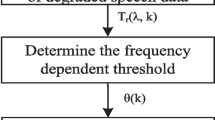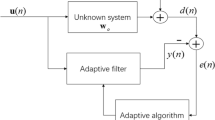Abstract
Most research papers have referred that the performance of bit error rate (BER) for a Multiple-Input Multipl-Output Space–Time Block Code (MIMO-STBC) decoder fundamentally relies on the number of pilot symbols. This paper proposes a new strategy for decoding a MIMO-STBC using blind source separation (BSS). First, the STBC decoder is modeled as a noisy linear mixing system, which is decomposed using the technique of real-imaginary (Re-Im). Then Kurtosis based BSS algorithm is applied to the decomposition model. The method of one source extraction is also used to reduce decoding time efficiently. Finally, a global particle swarm optimization method (GPSO) is combined with the one source extraction Kurtosis based BSS to obtain a high speed/low complexity MIMO-STBC decoder. The classical PSO algorithm in this paper is modified by innovating a new updating formula, which is the combination of the swarm behavior and BSS algorithm. Although the new decoder is more complicated as compared with the conventional one, it provides superior BER performance using a fewer number of pilot symbols. Computer simulation for QPSK STBC in a quasi-static flat fading MIMO channel was implemented using MATLAB2018. The new decoder algorithm was tested using only two receivers, worst case. The important point denoted through simulation is the BER performance of the proposed decoder was significantly got better when the length of frames gets longer. The proposed strategy was also used in decoding the \(8\times 8\) MIMO-STBC system in an extreme noise environment. It was found the BER performance improved nine times as compared with the traditional decoder. Finally, the modified GPSO algorithm made the proposed decoder needs a very small number of iterations, even though the search space dimension is very high.










Similar content being viewed by others
References
Ali R et al (2018) Improved salp swarm algorithm based on particle swarm optimization for feature selection. J Amb Intell Humani Comput 10(8):3155–3169
Alrufaiaat SAK, Althahab AQJ (2019) A new DOA estimation approach for QPSK alamouti STBC using ICA technique-based PSO algorithm. Int J Commun Syst 32(2):1–12
Andrei L (2012) BER analysis of STBC codes for MIMO Rayleigh flat fading channels. Telfor J 4(2):78–82
Bhaskar V, Kandpal D (2017) Generalized selection combining scheme for orthogonal space—time block codes with M-QAM and M-PAM modulation schemes. Wirel Pers Commun 94(3):1619–1641
Biguesh M, Gershman A (2006) Experimental proof of a load training-based MIMO channel estimation: a study of estimator tradeoffs and optimal training signals. IEEE Trans Signal Process 54(3):884–893
Chen L, Zhang L, Liu T, Li Q (2011) Blind signal separation algorithm based on bacterial foraging optimization. In: International conference on applied informatics and communication. Springer, Berlin, pp 359–366
Cichocki A, Amari SI (2002) Adaptive blind signal and image processing: learning algorithms and applications. Wiley
Clerc M, Kennedy J (2002) The particle swarm—explosion, stability, and convergence in a multidimensional complex space. IEEE Trans Evol Comput 6(1):58–73
Djordjevic IB (2017) Advanced optical and wireless communications systems. Springer, Heidelberg
Gao Y, Xie S (2004) A blind source separation algorithm using particle swarm optimization. In: Proceedings of the IEEE 6th circuits and systems symposium on emerging technologies: frontiers of mobile and wireless communication, vol 1, issue 3, pp 297–300
Huang C et al (2019) The performance analysis of multi-hop MIMO free space optical communications with space-time block codes over exponentiated weibull fading channels. Opt Commun 442:95–100
Hyva¨rinen A, Oja E (2000) Independent component analysis: algorithms and applications. Neural Netw 13(4–5):411–430
Hyvarinen A (1999) Fast and robust fixed-point algorithms for independent component analysis. IEEE Trans Neural Netw 10(3):626–634
Li ZC, Huang XL (2018) A novel blind source separation approach based on invasive weed optimization. In: DEStech transactions on computer science and engineering (cnai), pp 43–48
Li X, Luo T, Yue G, Yin C (2001) A squaring method to simplify the decoding of orthogonal space-time block codes. IEEE Trans Commun 49(10):1700–1703
Liu W, Mandic DP (2006) A normalised Kurtosis-based algorithm for blind source extraction from noisy measurements. Signal Process 86(7):1580–1585
Luo Z, Li C, Zhu L (2018) A comprehensive survey on blind source separation for wireless adaptive processing: principles, perspectives, challenges and new research directions. IEEE Access 6:66685–66708
Maaref A (2006) Performance analysis of orthogonal space-time block codes in spatially correlated MIMO Nakagami fading channels. IEEE Trans Wirel Commun 5(4):807–817
Oyerinde OO, Mneney SH (2012) Review of channel estimation for wireless communication systems. IETE Tech Rev 29(4):282–298
Tarokh V, Jafarkhani H, Calderbank AR (1999) Space-time block codes from orthogonal designs. IEEE Trans Inf Theory 45(5):1456–1467
Uddin Z, Ahmad A, Iqbal M (2017) ICA based MIMO transceiver for time varying wireless channels utilizing smaller data blocks lengths. Wirel Pers Commun 94(4):3147–3161
Wang W, Xiu Y, Zhang Z (2017) FDD massive MIMO downlink channel estimation with complex hybrid generalized approximate message passing algorithm. J Amb Intell Humaniz Comput 10(5):1769–1786
Xue J, Zhong C, Ratnarajah T (2012) Performance analysis of orthogonal STBC in generalized-K fading MIMO channels. IEEE Trans Veh Technol 61(3):1473–1479
Yang XS (2010) Engineering optimization: an introduction with metaheuristic applications. Wiley, Hoboken
Author information
Authors and Affiliations
Corresponding author
Additional information
Publisher's Note
Springer Nature remains neutral with regard to jurisdictional claims in published maps and institutional affiliations.
Rights and permissions
About this article
Cite this article
Alrufaiaat, S.A.K., Althahab, A.Q.J. Robust decoding strategy of MIMO-STBC using one source Kurtosis based GPSO algorithm. J Ambient Intell Human Comput 12, 1967–1980 (2021). https://doi.org/10.1007/s12652-020-02288-1
Received:
Accepted:
Published:
Issue Date:
DOI: https://doi.org/10.1007/s12652-020-02288-1




